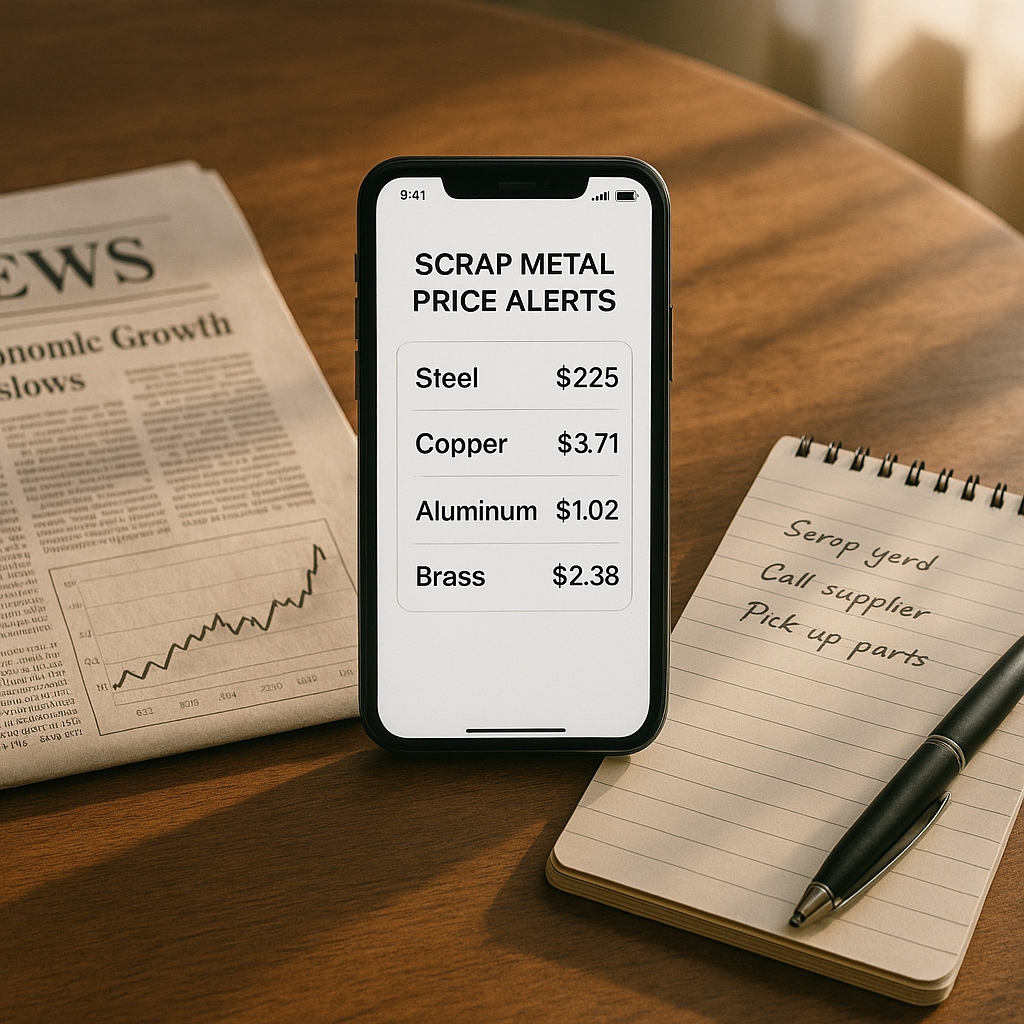5901 Botham Jean Blvd, Dallas, TX 75215
Scrap Metal Prices 2025: What Drives Value and How Businesses Can Maximize Returns
August 19, 2025The scrap metal market operates in a dynamic environment where prices change daily. Steel scrap currently trades between $350 and $550 per ton globally, with American sellers typically receiving 10 to 30 cents per pound. Copper, one of the most valuable scrap metals, commands premium rates exceeding $3 per pound for clean material. Aluminum generally fetches between 25 and 50 cents per pound, depending on its quality and type.
Supply and demand fundamentally drive these fluctuations. When industrial demand rises and material availability is limited, prices increase. Conversely, prices decrease during periods of oversupply or low demand. This economic principle applies across all metal categories in the recycling industry.
Global economic conditions directly influence the market. Manufacturing growth boosts demand for raw materials, raising prices. In contrast, economic downturns typically lead to lower industrial output and reduced scrap metal values. The pandemic highlighted this relationship in 2020 when prices plummeted before rebounding strongly in 2022.
How can businesses monitor scrap metal prices effectively?

In the dynamic scrap metal industry, prices fluctuate daily based on market conditions, global economic factors, and local demand. Businesses tracking these price movements closely can make strategic decisions about when to buy or sell scrap metal, ultimately maximizing profits.
Effective price monitoring involves using multiple information sources and establishing reliable systems to track market trends. Companies with robust monitoring practices gain a competitive edge by identifying favorable selling opportunities and avoiding unfavorable market conditions.
Online Resources for Real-Time Price Tracking
The internet offers numerous reliable platforms for tracking current scrap metal prices. These resources provide valuable insights into market trends and price fluctuations without requiring phone calls or in-person visits.
- Industry websites: Platforms like iScrapApp, Recycling Today, and Metalary regularly update pricing information and offer historical data to help identify trends.
- Mobile applications: Specialized apps provide real-time pricing alerts, allowing businesses to receive notifications when prices for specific metals reach desired thresholds.
- Metal exchange websites: Sites tracking the London Metal Exchange (LME) and other commodity exchanges offer broader market insights influencing local scrap prices.
- Subscription services: Premium market intelligence platforms offer detailed analysis, forecasting, and customized price reports for serious scrap metal operations.
Building Relationships with Local Scrap Yards
While online resources provide excellent general information, local market conditions can vary significantly. Establishing direct connections with nearby scrap yards delivers more accurate pricing specific to your region.
Regular communication with scrap yard managers gives businesses access to pricing insights that may not be publicly available. These relationships often lead to better rates and insider knowledge about upcoming market shifts based on local supply and demand dynamics.
Industry Forums and Networking
Connecting with other industry professionals creates valuable information-sharing opportunities that help businesses stay current on pricing trends. Industry knowledge is often shared through:
- Social media groups: Specialized Facebook groups and LinkedIn communities where scrap professionals discuss current prices and market conditions.
- Trade associations: Organizations like ISRI (Institute of Scrap Recycling Industries) provide member resources including market reports and industry analysis.
- Industry conferences: Events where experts discuss market projections and pricing factors that may affect future scrap values.
- Online forums: Platforms like Reddit’s r/ScrapMetal where recyclers share recent pricing experiences from different regions.
Creating Systematic Monitoring Processes
Effective price monitoring requires consistent systems rather than sporadic checks. Businesses should implement structured approaches to track price movements over time.
Setting up spreadsheets or databases to record daily or weekly price points helps identify patterns and seasonal trends. This historical data becomes increasingly valuable over time, enabling more accurate forecasting and strategic planning.
Factors to Monitor Beyond Base Prices
Smart businesses look beyond raw price numbers to understand the complete market picture. Several additional factors influence effective price monitoring:
- Transportation costs: Fuel prices and distance to scrap yards affect net profitability even when scrap prices are favorable.
- Grade specifications: Requirements for material quality and preparation can change, affecting the final price received.
- Market timing: Seasonal patterns often emerge in scrap pricing, creating predictable windows for more favorable transactions.
- Economic indicators: Construction activity, manufacturing output, and commodity futures all provide early signals of potential price movements.
By implementing comprehensive monitoring strategies across these multiple channels, businesses can capitalize on favorable market conditions while minimizing exposure to price downturns. This systematic approach transforms price monitoring from a reactive task into a strategic advantage in the competitive scrap metal industry.
Regular price monitoring allows companies to adjust their operational strategies, optimize inventory management, and make informed decisions about when to hold or sell material based on current market conditions.
What factors influence scrap metal prices?

Scrap metal prices fluctuate based on several key economic and market forces. Global supply and demand dynamics form the foundation of pricing. When industries like construction, automotive, and manufacturing experience growth, demand for scrap metal rises, pushing prices upward. Conversely, during economic slowdowns, reduced industrial activity leads to lower demand and declining prices.
Global economic conditions significantly impact the scrap metal market. During periods of economic expansion, industrial production increases, creating higher demand for raw materials including recycled metals. For example, following the 2008 financial crisis, scrap metal prices dropped sharply due to reduced industrial activity, while recent economic recovery has helped stabilize prices.
The specific type and quality of metal directly affect its market value. Copper consistently ranks among the most valuable scrap metals due to its high conductivity and versatility in electronics and construction. Clean, uncontaminated metals fetch higher prices as they require less processing. For instance, bare bright copper wire commands a premium over copper mixed with other materials.
Industrial activity serves as a reliable indicator of scrap metal pricing trends. Manufacturing output, construction projects, and automotive production directly influence demand. Seasonal patterns also emerge, with construction typically increasing during warmer months, driving up demand for metals like steel and aluminum.
International trade policies and tariffs can dramatically alter scrap metal markets. Import and export restrictions can create supply shortages or surpluses in different regions. When countries implement tariffs, the cost of trading metal scrap increases, affecting prices for end-users. The global nature of the scrap industry means changes in one region ripple throughout international markets.
Energy and transportation costs directly impact pricing. Recycling metals requires significant energy for processing, sorting, and melting. When fuel prices rise, collection and transportation expenses increase, typically resulting in lower prices offered to sellers. Processing facilities must account for these operational costs when determining what they can pay for scrap materials.
Currency exchange rates play a crucial role in global scrap metal trading. Since many transactions occur internationally with prices set in U.S. dollars, fluctuations in currency values can either strengthen or weaken purchasing power. A stronger domestic currency makes exports more expensive and potentially lowers demand, while a weaker currency can boost exports and increase prices.
Technological advancements in recycling processes can also influence pricing. Improved recycling technologies increase efficiency in metal recovery, potentially affecting supply levels. Innovations in material usage and alternatives may either increase or decrease reliance on certain types of scrap metals, shifting demand patterns.
What strategies can maximize profits with current scrap metal prices?

The scrap metal market offers significant profit potential for businesses and municipalities that approach it strategically. Current projections indicate growth from $55.20 million in 2020 to $83.77 million by 2028, representing a 7.2% compound annual growth rate. To capitalize on this expanding market, implementing effective strategies is essential. Let’s explore proven approaches to maximize your returns.
Strategic Metal Sorting and Preparation
Proper sorting is fundamental to profitable scrap metal recycling. Unsorted materials typically sell for 20-40% less than well-categorized scrap. Begin by separating ferrous (magnetic) metals from non-ferrous (non-magnetic) materials using a simple magnet test.
Further sorting by grade significantly increases value. For instance, clean copper wire without insulation can fetch nearly double the price of unsorted copper with insulation—up to $3.20 per pound compared to approximately $1.70 per pound. This price differential makes the extra sorting effort worthwhile.
Removing non-metallic attachments, insulation, and contaminants before selling will significantly boost your returns. Consider creating a dedicated sorting space with specific containers for different metal types to prevent cross-contamination, which reduces value.
Bulk Purchasing for Volume Discounts
Buying scrap metal in larger quantities usually results in better per-pound pricing. Volume purchasing creates economies of scale that benefit both buyers and sellers. When you purchase in bulk, transportation and processing costs are spread across more material, reducing the per-unit expense.
For municipalities and businesses generating substantial waste, establishing regular collection schedules can help accumulate larger quantities before selling. Similarly, partnering with other organizations to combine smaller lots into larger shipments can help everyone access better pricing.
Timing these bulk purchases strategically based on market conditions can further enhance profits. Consider establishing relationships with multiple suppliers to ensure consistent access to materials at competitive prices.
Market Research and Price Monitoring
Scrap metal prices fluctuate based on factors like global demand, economic conditions, and seasonal patterns. Implementing a systematic approach to tracking these fluctuations can significantly impact your bottom line.
Seasonal trends show that prices often peak during spring and summer months due to increased construction activity, while winter months—particularly from November to January—usually see lower prices. Additionally, midweek (Tuesday through Thursday) often presents better selling opportunities than Mondays and Fridays, which experience higher traffic at yards.
Digital tools have transformed how buyers and sellers track market conditions. Resources like price index trackers provide valuable data on price movements for various metals, including aluminum, copper, brass, and steel. Some applications even offer alerts when prices reach predetermined thresholds.
By monitoring these trends, you can make informed decisions about when to buy, sell, or hold inventory—potentially increasing profits by 10-15% compared to selling at random intervals.
Building Strong Relationships with Buyers
Developing solid relationships with scrap yard managers and staff can lead to preferential treatment and better pricing. Regular sellers often benefit from improved rates, faster service, and valuable market insights that occasional customers miss.
When approaching scrap yards, always call ahead to verify current prices and create accountability by requesting the name of the person providing the quote. Once on-site, position yourself to observe the weighing process and carefully verify your receipt to ensure weights and prices match what was quoted.
Don’t hesitate to negotiate prices, especially for larger quantities or consistent business. While not all yards advertise this fact, prices are often flexible. One local contractor secured an additional $45 after politely questioning a 15-pound discrepancy on his brass recycling ticket—demonstrating how attention to detail in these relationships can directly impact profits.
Regular Strategy Review and Optimization
The recycling industry evolves continuously, making regular assessment of your approach essential. Set quarterly reviews of your buying, sorting, and selling processes to identify improvement opportunities. Analyze which metal types and grades are delivering the highest returns and adjust your focus accordingly.
Consider tracking key performance indicators such as price obtained per pound, processing costs, and profit margins by metal type. This data-driven approach allows for informed decisions about which materials to prioritize and which practices to refine.
Stay informed about new recycling technologies and market developments that could impact your operation. Industry publications, trade associations, and networking with other recyclers can provide valuable insights that keep your strategy current and competitive.
How to stay updated on scrap metal pricing: Key takeaways

Keeping up with scrap metal prices is essential for making profitable decisions in the recycling industry. Throughout this article, we’ve covered various methods to monitor market trends and pricing fluctuations. Successful industry participants combine multiple information sources to gain a comprehensive understanding of market conditions.
Online resources such as iScrap App, Fastmarkets, and industry-specific websites provide daily price updates and market analyses. Building strong relationships with local scrap yards can offer real-time, regional pricing information that might differ from national averages. Understanding the key factors that influence prices, like global manufacturing activity, tariff policies, and seasonal trends, allows you to anticipate market shifts instead of merely reacting to them. Most importantly, developing a consistent monitoring routine ensures you won’t miss opportunities when favorable pricing conditions arise.
For professional assistance with your recycling needs, contact Okon Recycling at 214-717-4083. Our team of experts can help you handle market fluctuations and maximize the value of your scrap metal materials.
